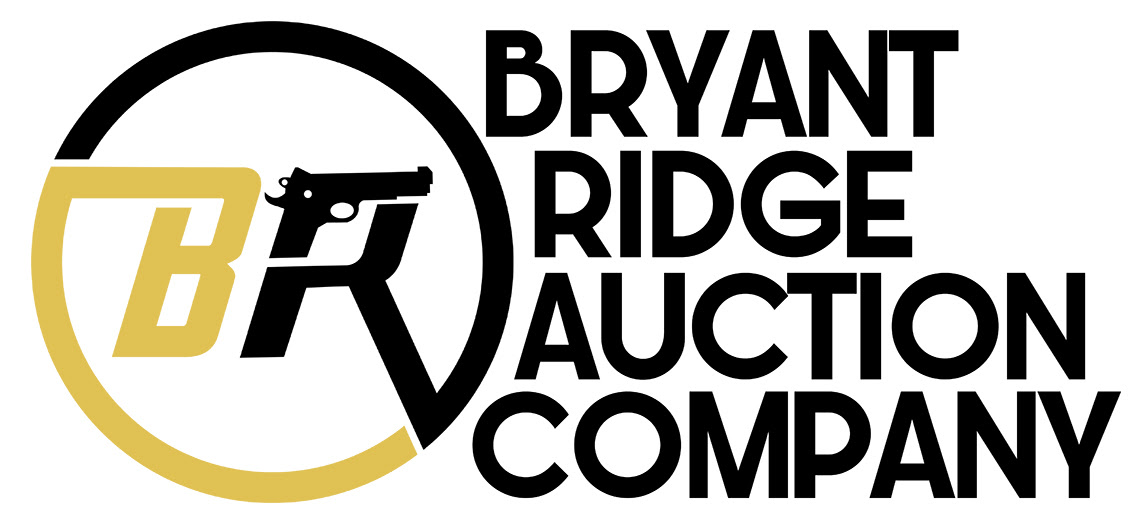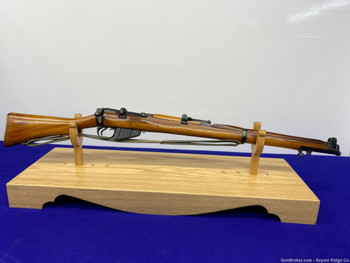Description

Item Description
Bryant Ridge Auction Company is pleased to present this historic bolt-action rifle for a penny-start auction today; this is the Ishapore No.1 Mk III!
This Indian military No.1 Mk III underwent a fascinating transformation from its original Ishapore SMLE configuration in .303 British, manufactured in 1942, to a .410 gauge shotgun by Ishapore in 1949. The conversion process included boring out the barrel to accommodate .410 gauge shotshells, inserting a cupped metal plate into the magazine well, plugging the magazine well with wood, and permanently adjusting the rear sight slide for shotshell use by pinning it in place. The details of the conversion, including the facility and completion date, were stamped on the left side of the receiver beneath the safety. These modified rifles saw service with Indian military guards and police from the 1950s through the 1980s. They provided personnel with a means of self-defense using shotshells that offered limited range and penetration, minimizing the risk of collateral damage compared to bullets. However, their conversion also restricted their offensive capability, ensuring that they were less effective in potential confrontations where their adversaries possessed standard SMLE rifles chambered in .303 caliber.
This Indian military No.1 Mk III underwent a fascinating transformation from its original Ishapore SMLE configuration in .303 British, manufactured in 1942, to a .410 gauge shotgun by Ishapore in 1949. The conversion process included boring out the barrel to accommodate .410 gauge shotshells, inserting a cupped metal plate into the magazine well, plugging the magazine well with wood, and permanently adjusting the rear sight slide for shotshell use by pinning it in place. The details of the conversion, including the facility and completion date, were stamped on the left side of the receiver beneath the safety. These modified rifles saw service with Indian military guards and police from the 1950s through the 1980s. They provided personnel with a means of self-defense using shotshells that offered limited range and penetration, minimizing the risk of collateral damage compared to bullets. However, their conversion also restricted their offensive capability, ensuring that they were less effective in potential confrontations where their adversaries possessed standard SMLE rifles chambered in .303 caliber.
SPECIFICATIONS:
Manufacturer: Rifle Factory Ishapore (R.F.I.), India
Model: No.1 Mk III
Serial: 1425G
Date of Manufacture: 1942
Caliber: .410 Gauge
Finish: Blue
Barrel Length: 25"
Optics/Sights: Wing Protected Blade Front with U-Notched Escalator Sight Marked 2-20 Rear
Stock/Grips: Smooth Hardwood
Action: Bolt-Action
Markings: The right side of the stock collar is marked "crown / G.R.I. / 1942 / No.1 MKIII," and the left side is marked "410 / RFI / 1949." The left front of the receiver is marked with an Indian “crown / GRI / crossed flags / P” proof. The serial number "1425G" is stamped on the right side of the receiver, rear bolt handle, nose cap, and rear sight. There are other proof stampings scattered around the stock and metal components.
Bryant Ridge's Analysis:
The Lee-Enfield SMLE Mk III, introduced in January 1907, marked a significant evolution in military firearms design. It featured improvements such as a simplified rear sight, enhanced handguards, and a modified magazine to accommodate the new Mk VII high-velocity .303 ammunition. During World War I, the initial complexity of manufacturing the Mk III prompted simplifications in the Mk III* variant, which omitted features like the magazine cut-off mechanism and long-range volley sights to expedite production. These changes were implemented variably across different factories and continued to evolve post-war, with some rifles retaining the magazine cut-off until the 1960s. The SMLE Mk III* gained prominence during World War II, serving extensively in theaters like North Africa, Italy, the Pacific, and Burma with British and Commonwealth forces. Australia and India maintained their production of the Mk III* throughout the conflict and beyond, with Australia using it into the Korean War before transitioning to newer rifles. The Ishapore Rifle Factory in India further developed the rifle into the 2A and 2A1 models, adapted for 7.62x51mm NATO ammunition, ensuring its longevity well into the latter half of the 20th century. The Lee-Enfield's robust performance and reliability earned it the enduring nickname "three-oh-three" among servicemen and collectors alike.
Similarly, in India, RFI undertook conversions of MkIII rifles into single-shot muskets chambered for the .410 Indian musket cartridge. These conversions were intended for police and prison guards, offering reduced firepower and range compared to the original .303 cartridge. The decision was also influenced by logistical concerns, such as the potential difficulty in sourcing replacement ammunition in the event of theft or abandonment.
While conversions in Britain and Australia typically accommodated standard .410 shotgun cartridges of varying chamber lengths, Indian conversions were unique. Originally chambered for the .410 Indian musket cartridge, which is derived from the .303 British cartridge, these muskets cannot accept the common .410 shotgun cartridge. Many of these surplus muskets have since been rechambered to utilize commercially available ammunition, although unmodified versions require custom handloading due to the limited availability of the .410 Indian Musket cartridge since the 1950s.
Return Policy:
We gladly offer a 3 day unfired inspection policy from the time that the firearm is delivered to your FFL. Refunds are available for all qualifying orders.
Model: No.1 Mk III
Serial: 1425G
Date of Manufacture: 1942
Caliber: .410 Gauge
Finish: Blue
Barrel Length: 25"
Optics/Sights: Wing Protected Blade Front with U-Notched Escalator Sight Marked 2-20 Rear
Stock/Grips: Smooth Hardwood
Action: Bolt-Action
Markings: The right side of the stock collar is marked "crown / G.R.I. / 1942 / No.1 MKIII," and the left side is marked "410 / RFI / 1949." The left front of the receiver is marked with an Indian “crown / GRI / crossed flags / P” proof. The serial number "1425G" is stamped on the right side of the receiver, rear bolt handle, nose cap, and rear sight. There are other proof stampings scattered around the stock and metal components.
Bryant Ridge's Analysis:
The Lee-Enfield SMLE Mk III, introduced in January 1907, marked a significant evolution in military firearms design. It featured improvements such as a simplified rear sight, enhanced handguards, and a modified magazine to accommodate the new Mk VII high-velocity .303 ammunition. During World War I, the initial complexity of manufacturing the Mk III prompted simplifications in the Mk III* variant, which omitted features like the magazine cut-off mechanism and long-range volley sights to expedite production. These changes were implemented variably across different factories and continued to evolve post-war, with some rifles retaining the magazine cut-off until the 1960s. The SMLE Mk III* gained prominence during World War II, serving extensively in theaters like North Africa, Italy, the Pacific, and Burma with British and Commonwealth forces. Australia and India maintained their production of the Mk III* throughout the conflict and beyond, with Australia using it into the Korean War before transitioning to newer rifles. The Ishapore Rifle Factory in India further developed the rifle into the 2A and 2A1 models, adapted for 7.62x51mm NATO ammunition, ensuring its longevity well into the latter half of the 20th century. The Lee-Enfield's robust performance and reliability earned it the enduring nickname "three-oh-three" among servicemen and collectors alike.
The conversion of rifles to smoothbore guns occurred in various regions and for diverse reasons throughout history. In Australia, SAF Lithgow adapted MkIII rifles into shotguns branded as "Slazenger," utilizing the commercially popular .410 shotgun shell. This transformation was driven by stringent firearms legislation, which imposed restrictions on owning rifles chambered in military cartridges, while smoothbore shotguns faced fewer regulatory hurdles.
Similarly, in India, RFI undertook conversions of MkIII rifles into single-shot muskets chambered for the .410 Indian musket cartridge. These conversions were intended for police and prison guards, offering reduced firepower and range compared to the original .303 cartridge. The decision was also influenced by logistical concerns, such as the potential difficulty in sourcing replacement ammunition in the event of theft or abandonment.
While conversions in Britain and Australia typically accommodated standard .410 shotgun cartridges of varying chamber lengths, Indian conversions were unique. Originally chambered for the .410 Indian musket cartridge, which is derived from the .303 British cartridge, these muskets cannot accept the common .410 shotgun cartridge. Many of these surplus muskets have since been rechambered to utilize commercially available ammunition, although unmodified versions require custom handloading due to the limited availability of the .410 Indian Musket cartridge since the 1950s.
Return Policy:
We gladly offer a 3 day unfired inspection policy from the time that the firearm is delivered to your FFL. Refunds are available for all qualifying orders.
Shipping Details
Handgun Standard Shipping with Insurance $50.00
Long Gun Standard Shipping with Insurance $70.00
Any orders placed with magazines that are not compliant with your state, county, or city regulations will not ship with your order.
We strive to ship orders within the close of the following business day after payment and documentation is received.
Payment Details
We accept all forms of Payment including Personal Check, Business Check, PO Money Orders, Certified Check, Etc.
Please note we place a 7 business day hold on shipment, for all non-certified payments.
Payment MUST be received within 14 days.
Return Policy
We gladly offer a 3 day unfired inspection policy from the time that the firearm is delivered to your FFL. Refunds are available for all qualifying orders.
Additional Details
Our #1 priority is customer satisfaction. We want to build a lasting trust in the relationship with our customers, so that you will always look to us for all your firearms needs. If you have any issues with your transactions please contact us, and we will work with you to resolve any issues you may have. We greatly appreciate your trust in us and we look forward to fulfilling all your future firearm needs.
Bryant Ridge also reserves the right to cancel any sales that may occur while gunbroker.com is experiencing technical issues that affects the entire site or a complete site outage, within an hour of the auction ending.
We have an amazing inventory of classic and collector firearms that we are adding to Gunbroker daily. Stay up to date on all of our latest auction by adding us to your favorite sellers list.
About Us
From a small town hobby, to a leader in the investment and collector grade firearms industry. Bryant Ridge Firearms is here to offer the best in quality and customer service when you are looking to unload your collector grade firearm collection.
















